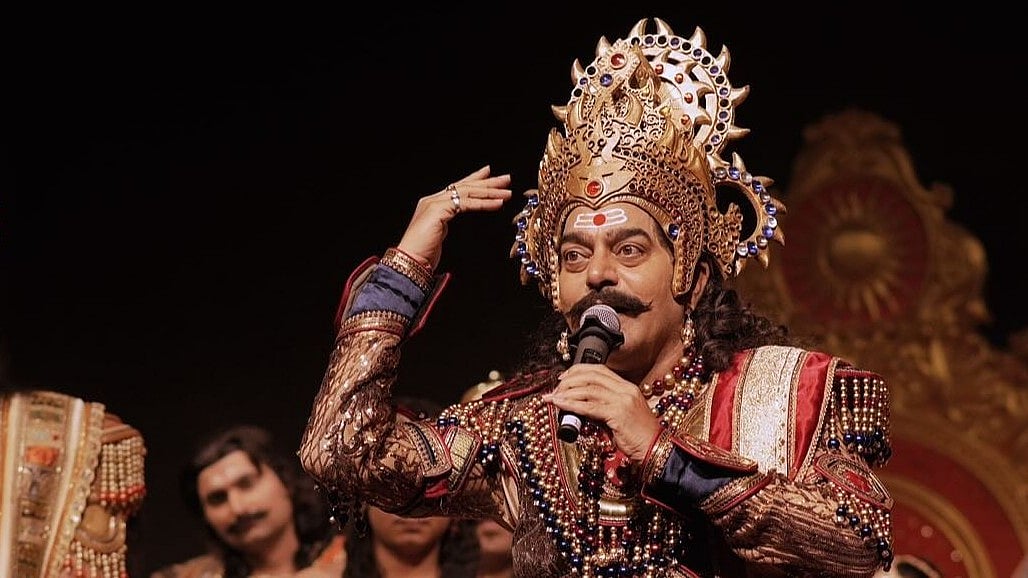His impeccable Hindi is as impressive and intimidating as the grey and complex characters he has played on the big screen. But miles away from the silver screen, Ashutosh Rana presents and enacts the larger-than-life villain, in the truest sense of the word, Ravan, on the stage with his play Humare Ram, with an interesting interpretation and equally engaging interplay of emotions and sensibilities. His play is scheduled to be staged across the country after receiving an overwhelming response at Mumbai’s NMACC.
In a freewheeling exclusive chat with The Free Press Journal, Rana discusses The Ramayana, Ram, and Ravan in his unique style, with an interpretation that is worth a mindful read (and a listen).
Ramayana’s timeless relevance for society
“The values cherished and encouraged in the Ramayana are as relevant today as they were ages ago. I firmly believe that the Ramayana is relevant and impactful because the text is significant for the upliftment of the whole society, as opposed to what has been narrated in the Geeta (therefore in the Mahabharata), which is largely reserved for the elevation, enhancement, and upliftment of an individual in terms of knowledge, neeti (principles), and spirituality,” says Ashutosh about how the epic text continues to stand the test of time and has been inspiring generations.
He continues, “There have been changes in the yugas, multiple changes in the rulers and the civilizations they have ruled, as well as the different political systems too, but even today, when it comes to looking at an ideal society, culture, or principles of living, we still use the term Ramrajya as a reference and not Krishnarajya, Shivarajya, or Buddharajya.”
The ethics, the principles, the moral codes, and the art of living mentioned and lived in the Ramayana are unmatched. “Isliye humein Prabhu Ram ji ke sirf charan hee nahi pakadne chahiye, balki unke aacharan ko bhi humein pakadna chahiye,” elaborates Ashutosh.
Ravana’s role in enhancing Rama
About the significance and the strength of Ravana, the complexity of his character, and his indelible mark on the text, Ashutosh further elaborates, “It’s the irony and perhaps the essence of the Ramayana that the wise, the devotee (shiv-bhakt), and the knowledgeable character that Ravan is, stands as a stark contrast against Rama as an enemy and not as a friend. Therefore, he brings out the best in the lord. It’s the shatru (enemy) who challenges you; he is the one who makes you feel insecure and takes you to the place of security. It’s the enemy who constantly provokes you and inspires you to push the envelope, stretching the horizon of possibilities. So, Ravana plays an integral role in enhancing and bringing forth the bravery and potential of Rama, I believe,” interprets Ashutosh.
“Ravana was wise enough to know that by being a friend, he would not be remembered as much as by being the nemesis, and he chose his death through the hands of Rama. Isliye humein ye bhi seekh milti hai ki shatru jo hote hain, woh tiraskaar ke nahi, balki namaskaar ke patra hote hain! In my mind, Ravan knew that if he chose a petty enemy, he would be dwarfed by their smallness, but if he chose Lord Rama as his enemy, then there was a possibility of elevating himself to a higher level and perhaps becoming like him. Now isn’t that fascinating! Ravan hote huye bhi, Rama banane ki jo prakriya hai, woh wahi jaan sakta hai jisne Rama ko samjha ho.”
Energy over greys
Did Ashutosh have to channel and utilise the dark side of his being in order to project Ravana on the stage, one wonders. How did he process the grey in order to project it? “I don’t believe in the greys. Take any character from my filmography and you would know that I don’t interpret the villains, so to speak, as negative. Because if the character feels that what he is doing is wrong, his buddhi and intellect wouldn’t allow him to do what he intends to. So when a character does anything out of his conviction, no matter what the end result of his action is, he is confident and positive. So I don’t see it as positive or negative; I simply believe it’s the transformation of energy.”
The audience has witnessed Ravan in all major media possible, from the small screen to the silver screen. What, therefore, is the USP of Ashutosh’s Ravan in terms of both production and performance? We quiz.
“The beauty and the USP of the Ravan that I played are based on, as indeed it revolves around, this thought: if Rama is the ultimate Brahma, the lord, and the truth, then the moment anybody comes into his energy field, that person ultimately becomes like Rama, if not Rama himself. Toh Ravan hote huye bhi, Ravan dikhayi na de, ye USP hai. Kyuki shatru ke saath rehte rehte, aap shatru jaise ban jaayenge.”
